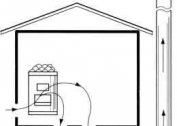Supply and exhaust ventilation in the garage
For the "home" of your car, your favorite "house", fresh air is also necessary, as well as for our own apartment. But how to arrange the proper ventilation of the garage? To do this, it is necessary to solve several basic issues.
Choosing a garage ventilation method
Garage ventilation happens:
- Natural;
- Combined;
- Mechanical.
The natural ventilation of the garage is always given greater preference, as this is the easiest way to create air circulation by yourself.
Combined ventilation, also called exhaust ventilation, is the removal of old air from the garage through the supply air vents using a fan.
Mechanical - the most proper garage ventilation - creates artificial air exchange with the help of special air handling units and air mass output devices through a two-channel system.
The air exchange system always depends on the owner’s wallet and the architectural parameters of the garage. If there is a viewing niche or even a cellar in it, then in all these depressions it is necessary to provide for an air flow so that the ventilation device in the garage eliminates the spoilage of supplies for the winter.
How to make a diagram of exhaust and supply ventilation in the garage?
At the design stage of the garage, you need to develop such a scheme in which the holes in the wall of the room, in the cellar / pit and in the basement will appear.
It takes into account the height, area and number of cars in the garage. Further, in this scheme, it will be necessary to note the underground and surface location of the pipelines, as well as consider all kinds of air vortex paths.
Natural ventilation of the garage, as well as artificial, uses a two-channel scheme. For artificial, sometimes a single hole is enough. But still, it is advisable to do two. To calculate the diameter of the ventilation holes, you must adhere to the following pattern: 1 m2 of the garage is equal to 15 mm of the diameter of the pipe.
That is, if the exhaust ventilation system in the garage is 10 m2 in area, then pipes can be safely taken with a diameter of 150 mm.
There is another method used for calculation: it takes 0.3% of the total garage area and is equal to the area of all ventilation holes. This formula is best used for single-channel mechanical garage air exchange.



